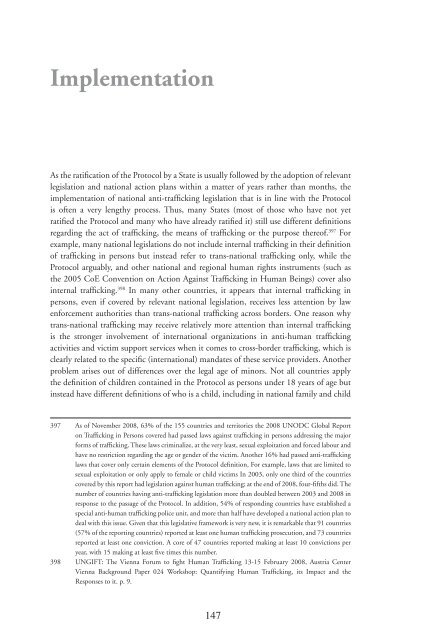Trafficking in human beings: human rights and ... - unesdoc - Unesco
Trafficking in human beings: human rights and ... - unesdoc - Unesco
Trafficking in human beings: human rights and ... - unesdoc - Unesco
Create successful ePaper yourself
Turn your PDF publications into a flip-book with our unique Google optimized e-Paper software.
Implementation<br />
As the ratifi cation of the Protocol by a State is usually followed by the adoption of relevant<br />
legislation <strong>and</strong> national action plans with<strong>in</strong> a matter of years rather than months, the<br />
implementation of national anti-traffi ck<strong>in</strong>g legislation that is <strong>in</strong> l<strong>in</strong>e with the Protocol<br />
is often a very lengthy process. Thus, many States (most of those who have not yet<br />
ratifi ed the Protocol <strong>and</strong> many who have already ratifi ed it) still use different defi nitions<br />
regard<strong>in</strong>g the act of traffi ck<strong>in</strong>g, the means of traffi ck<strong>in</strong>g or the purpose thereof. 397 For<br />
example, many national legislations do not <strong>in</strong>clude <strong>in</strong>ternal traffi ck<strong>in</strong>g <strong>in</strong> their defi nition<br />
of traffi ck<strong>in</strong>g <strong>in</strong> persons but <strong>in</strong>stead refer to trans-national traffi ck<strong>in</strong>g only, while the<br />
Protocol arguably, <strong>and</strong> other national <strong>and</strong> regional <strong>human</strong> <strong>rights</strong> <strong>in</strong>struments (such as<br />
the 2005 CoE Convention on Action Aga<strong>in</strong>st Traffi ck<strong>in</strong>g <strong>in</strong> Human Be<strong>in</strong>gs) cover also<br />
<strong>in</strong>ternal traffi ck<strong>in</strong>g. 398 In many other countries, it appears that <strong>in</strong>ternal traffi ck<strong>in</strong>g <strong>in</strong><br />
persons, even if covered by relevant national legislation, receives less attention by law<br />
enforcement authorities than trans-national traffi ck<strong>in</strong>g across borders. One reason why<br />
trans-national traffi ck<strong>in</strong>g may receive relatively more attention than <strong>in</strong>ternal traffi ck<strong>in</strong>g<br />
is the stronger <strong>in</strong>volvement of <strong>in</strong>ternational organizations <strong>in</strong> anti-<strong>human</strong> traffi ck<strong>in</strong>g<br />
activities <strong>and</strong> victim support services when it comes to cross-border traffi ck<strong>in</strong>g, which is<br />
clearly related to the specifi c (<strong>in</strong>ternational) m<strong>and</strong>ates of these service providers. Another<br />
problem arises out of differences over the legal age of m<strong>in</strong>ors. Not all countries apply<br />
the defi nition of children conta<strong>in</strong>ed <strong>in</strong> the Protocol as persons under 18 years of age but<br />
<strong>in</strong>stead have different defi nitions of who is a child, <strong>in</strong>clud<strong>in</strong>g <strong>in</strong> national family <strong>and</strong> child<br />
397 As of November 2008, 63% of the 155 countries <strong>and</strong> territories the 2008 UNODC Global Report<br />
on Traffi ck<strong>in</strong>g <strong>in</strong> Persons covered had passed laws aga<strong>in</strong>st traffi ck<strong>in</strong>g <strong>in</strong> persons address<strong>in</strong>g the major<br />
forms of traffi ck<strong>in</strong>g. These laws crim<strong>in</strong>alize, at the very least, sexual exploitation <strong>and</strong> forced labour <strong>and</strong><br />
have no restriction regard<strong>in</strong>g the age or gender of the victim. Another 16% had passed anti-traffi ck<strong>in</strong>g<br />
laws that cover only certa<strong>in</strong> elements of the Protocol defi nition, For example, laws that are limited to<br />
sexual exploitation or only apply to female or child victims In 2003, only one third of the countries<br />
covered by this report had legislation aga<strong>in</strong>st <strong>human</strong> traffi ck<strong>in</strong>g; at the end of 2008, four-fi fths did. The<br />
number of countries hav<strong>in</strong>g anti-traffi ck<strong>in</strong>g legislation more than doubled between 2003 <strong>and</strong> 2008 <strong>in</strong><br />
response to the passage of the Protocol. In addition, 54% of respond<strong>in</strong>g countries have established a<br />
special anti-<strong>human</strong> traffi ck<strong>in</strong>g police unit, <strong>and</strong> more than half have developed a national action plan to<br />
deal with this issue. Given that this legislative framework is very new, it is remarkable that 91 countries<br />
(57% of the report<strong>in</strong>g countries) reported at least one <strong>human</strong> traffi ck<strong>in</strong>g prosecution, <strong>and</strong> 73 countries<br />
reported at least one conviction. A core of 47 countries reported mak<strong>in</strong>g at least 10 convictions per<br />
year, with 15 mak<strong>in</strong>g at least fi ve times this number.<br />
398 UNGIFT: The Vienna Forum to fi ght Human Traffi ck<strong>in</strong>g 13-15 February 2008, Austria Center<br />
Vienna Background Paper 024 Workshop: Quantify<strong>in</strong>g Human Traffi ck<strong>in</strong>g, its Impact <strong>and</strong> the<br />
Responses to it. p. 9.<br />
147

















